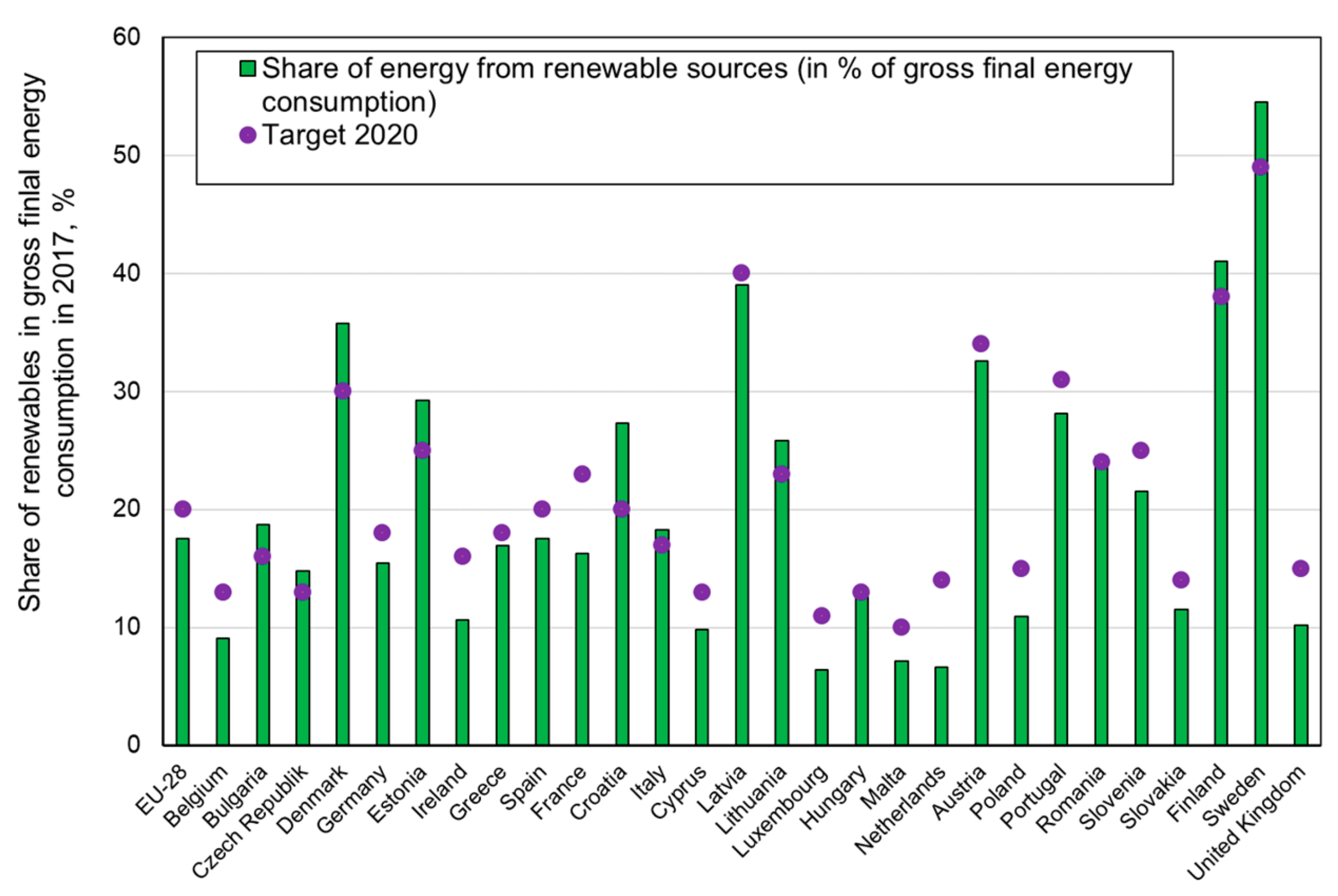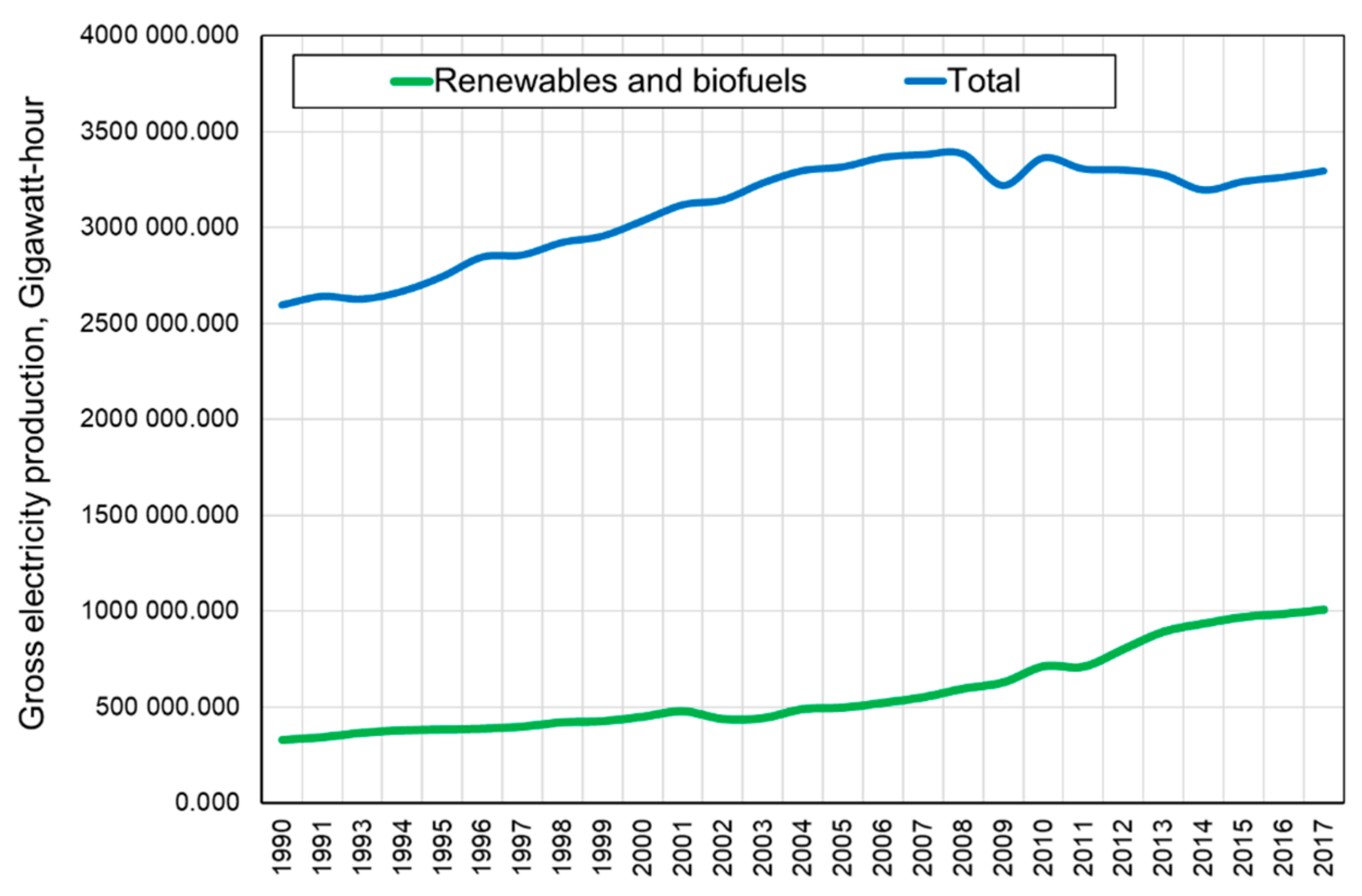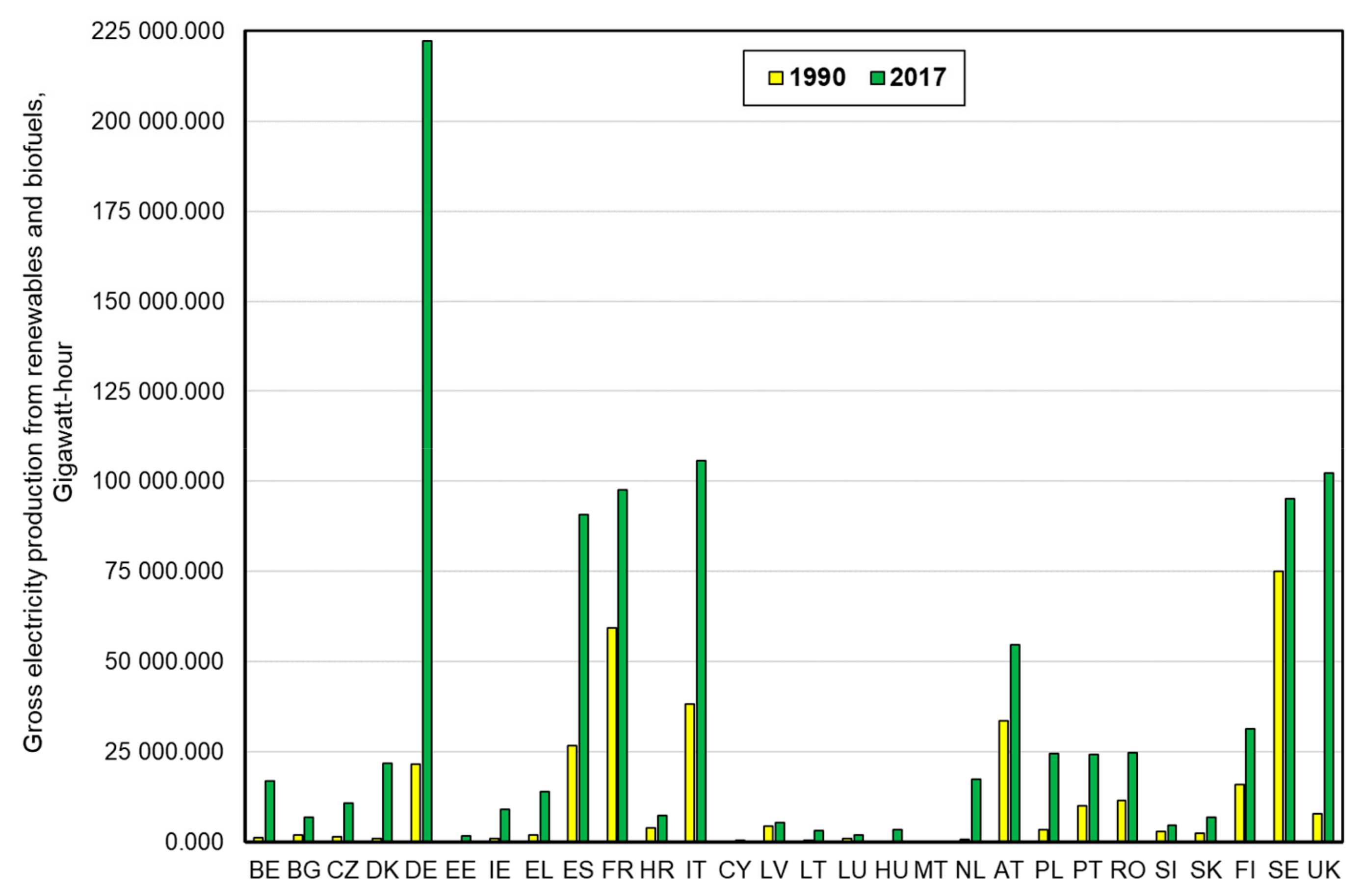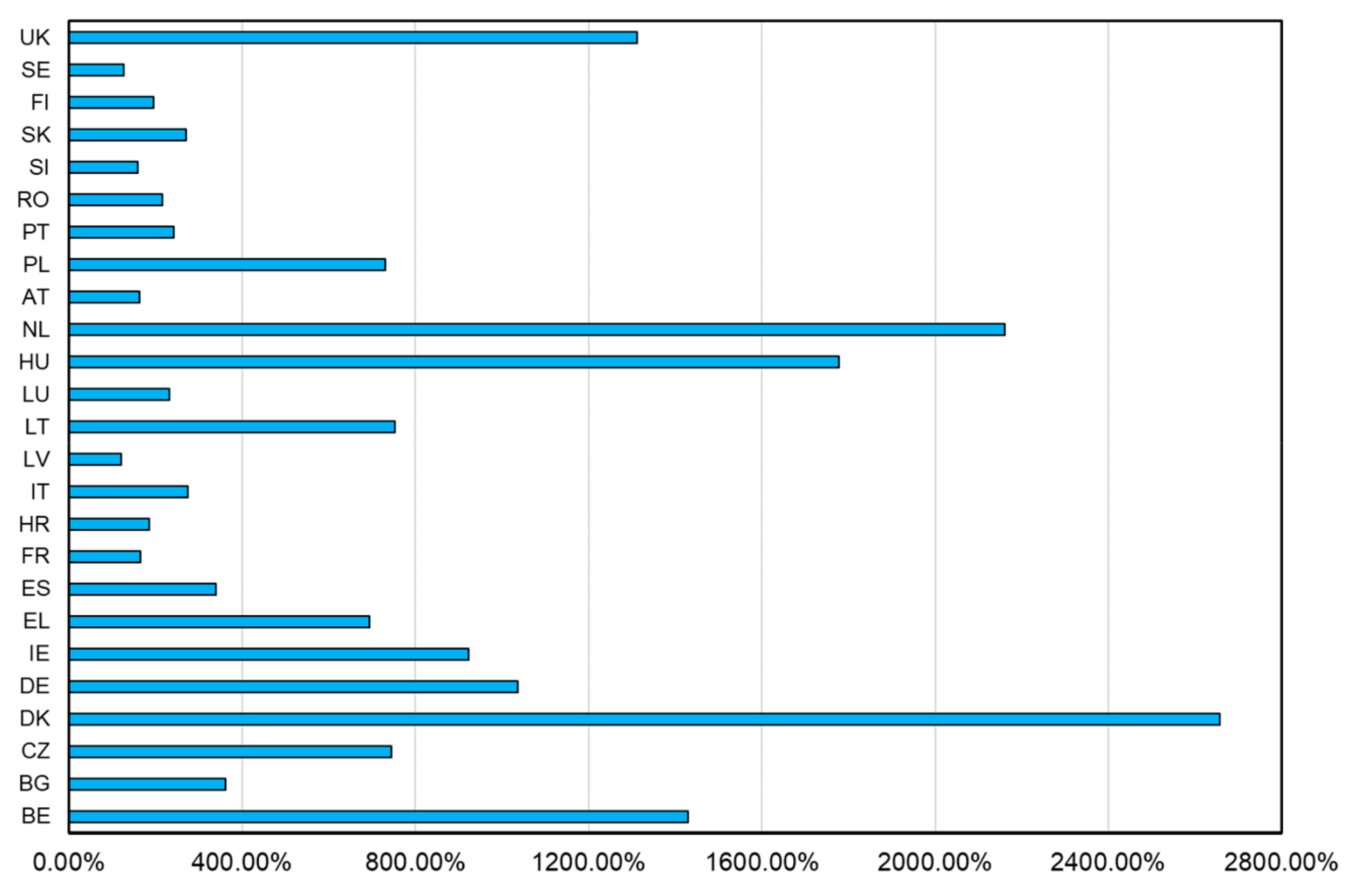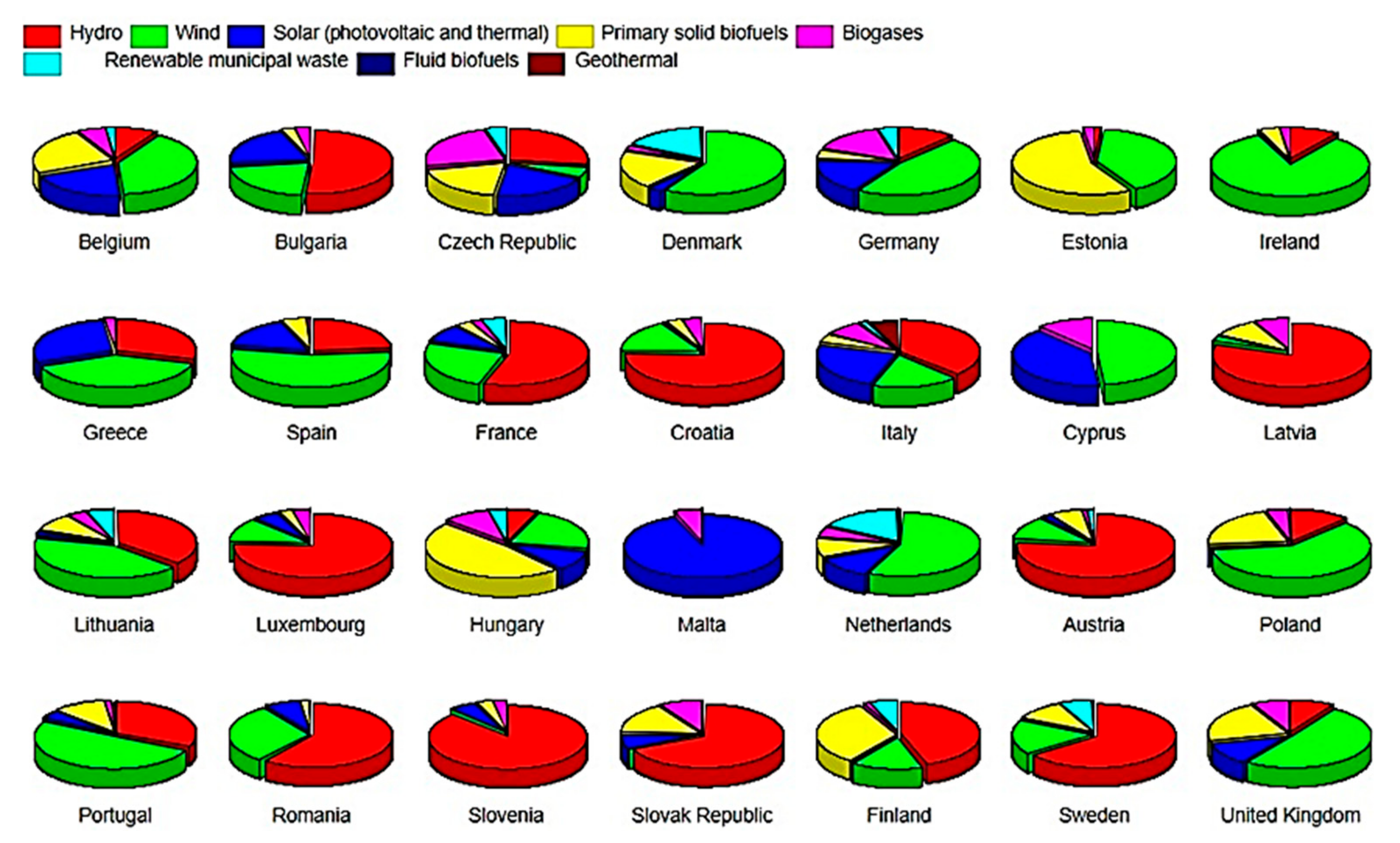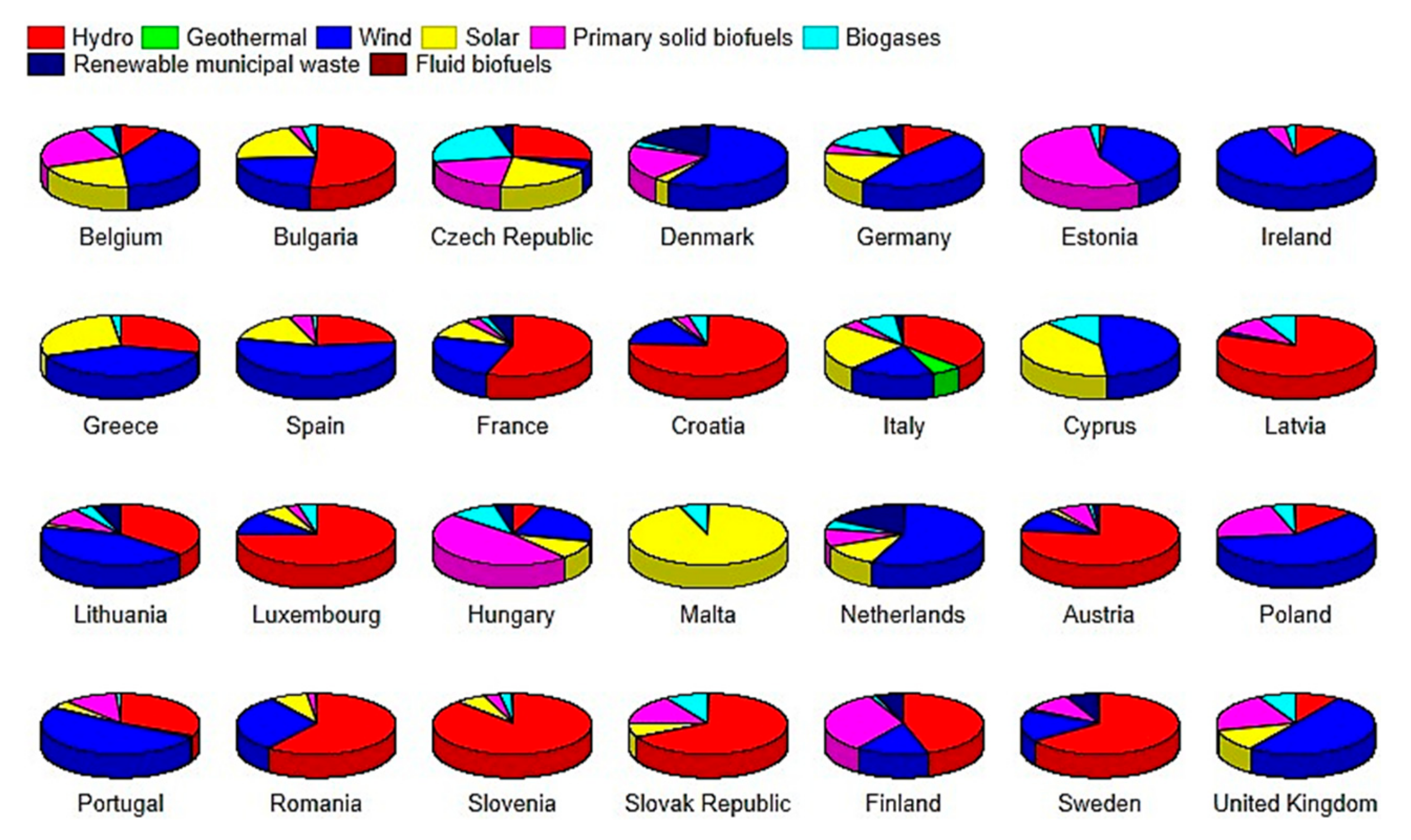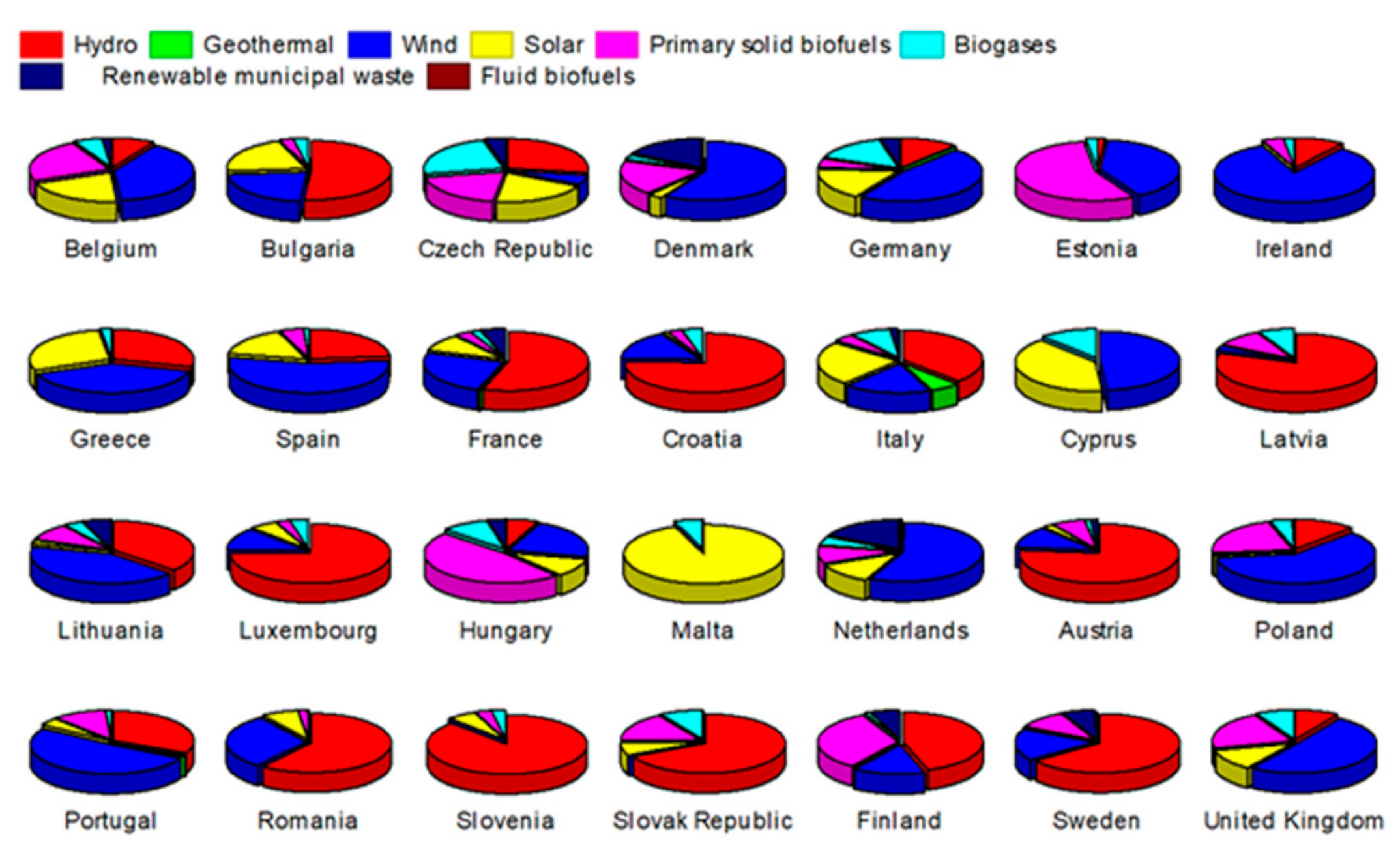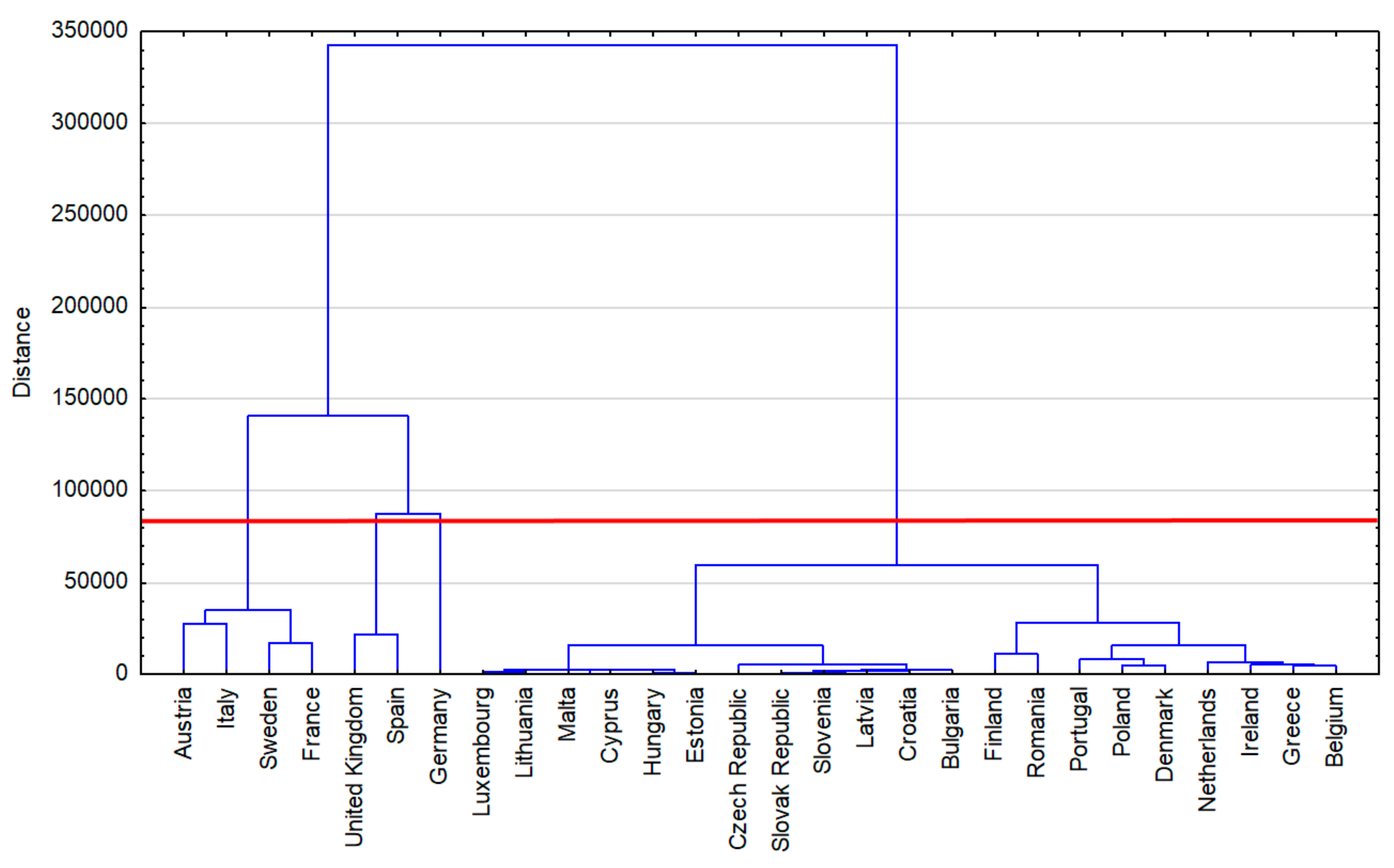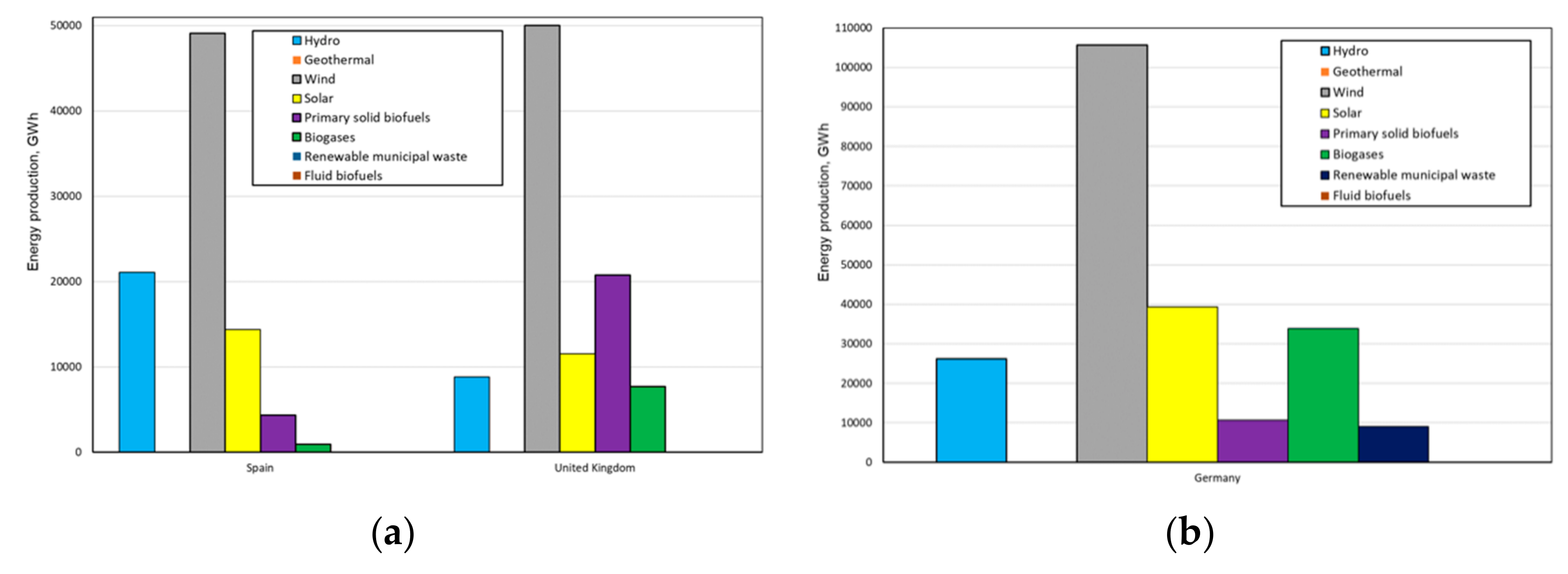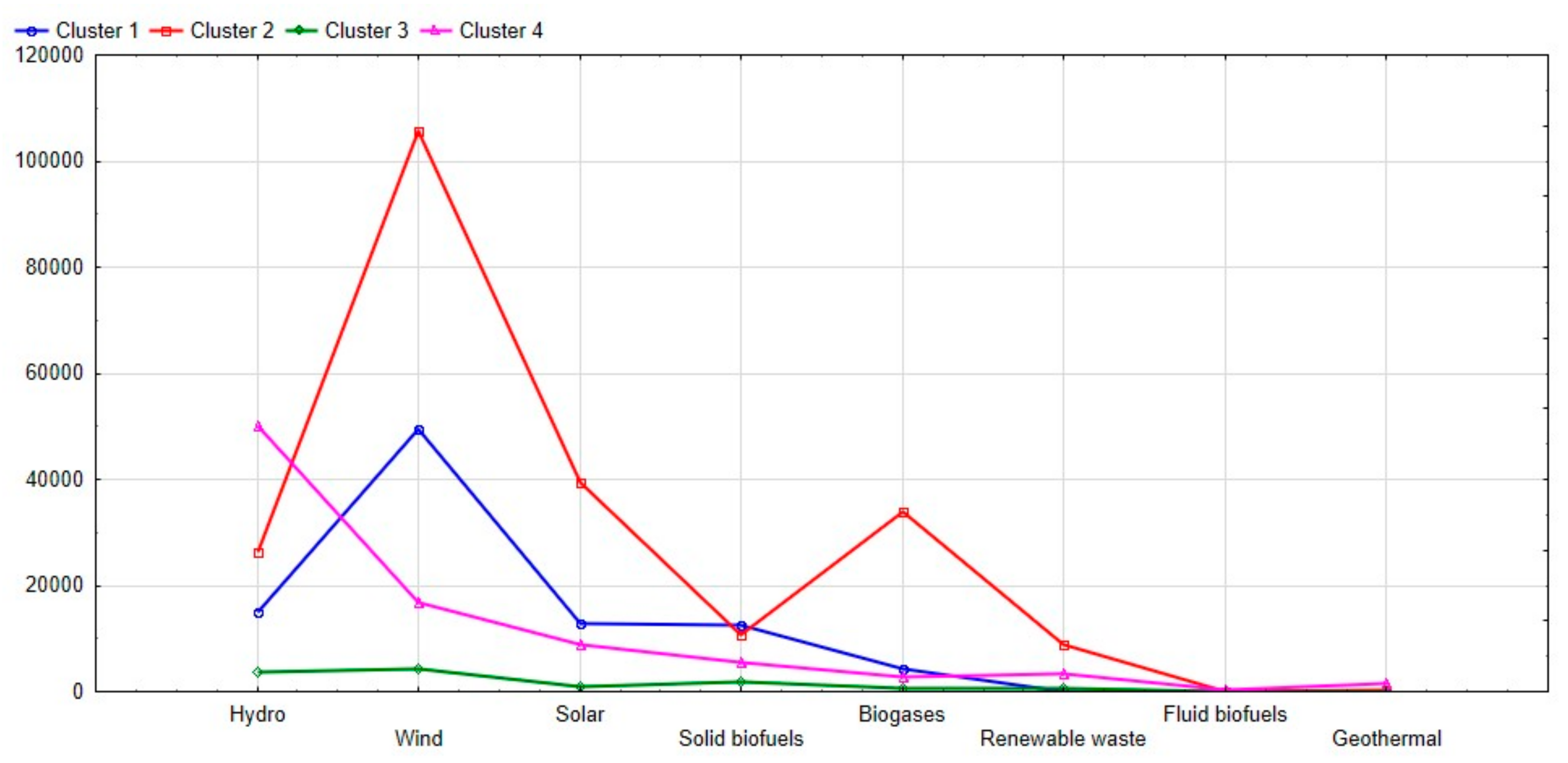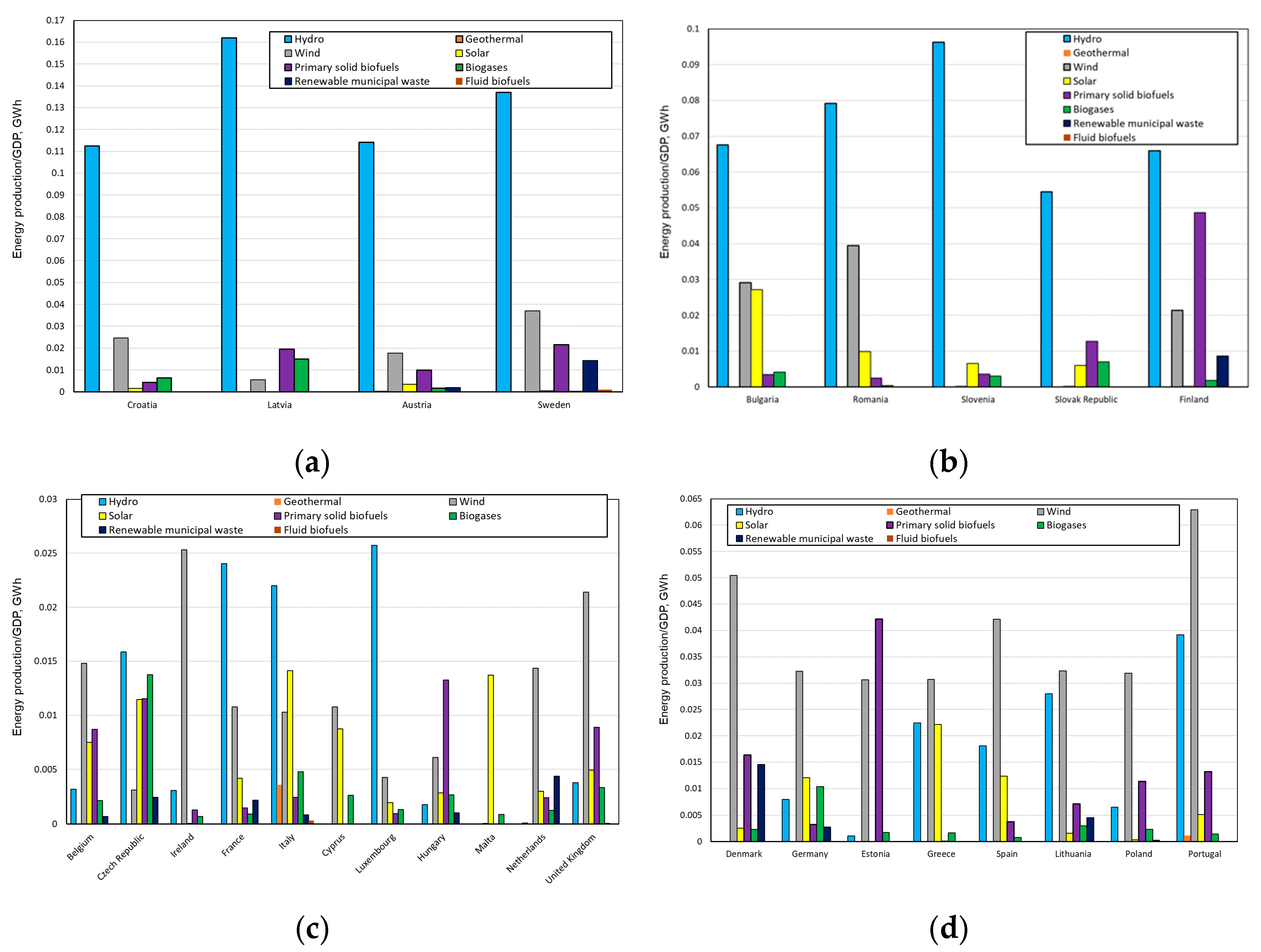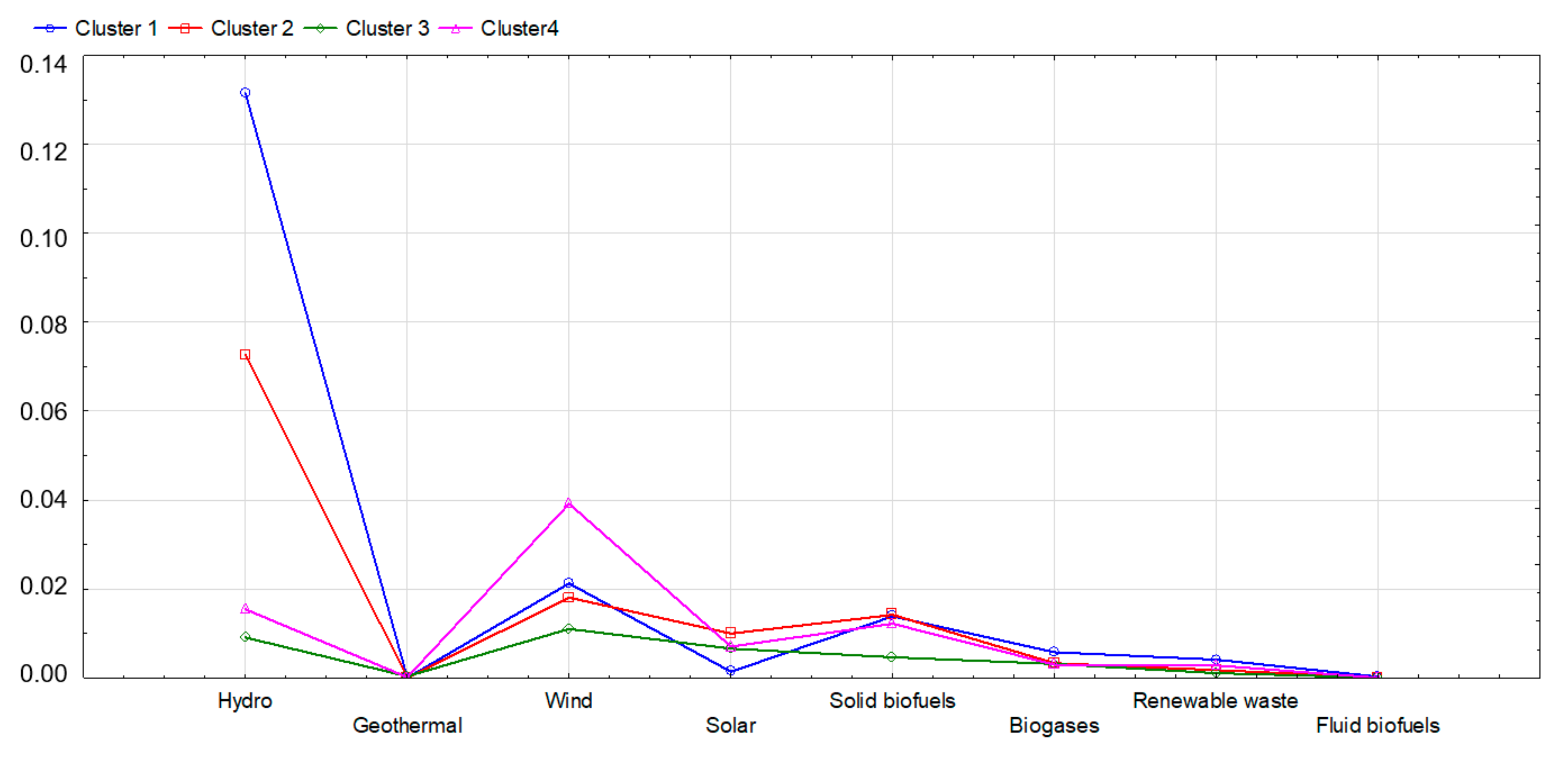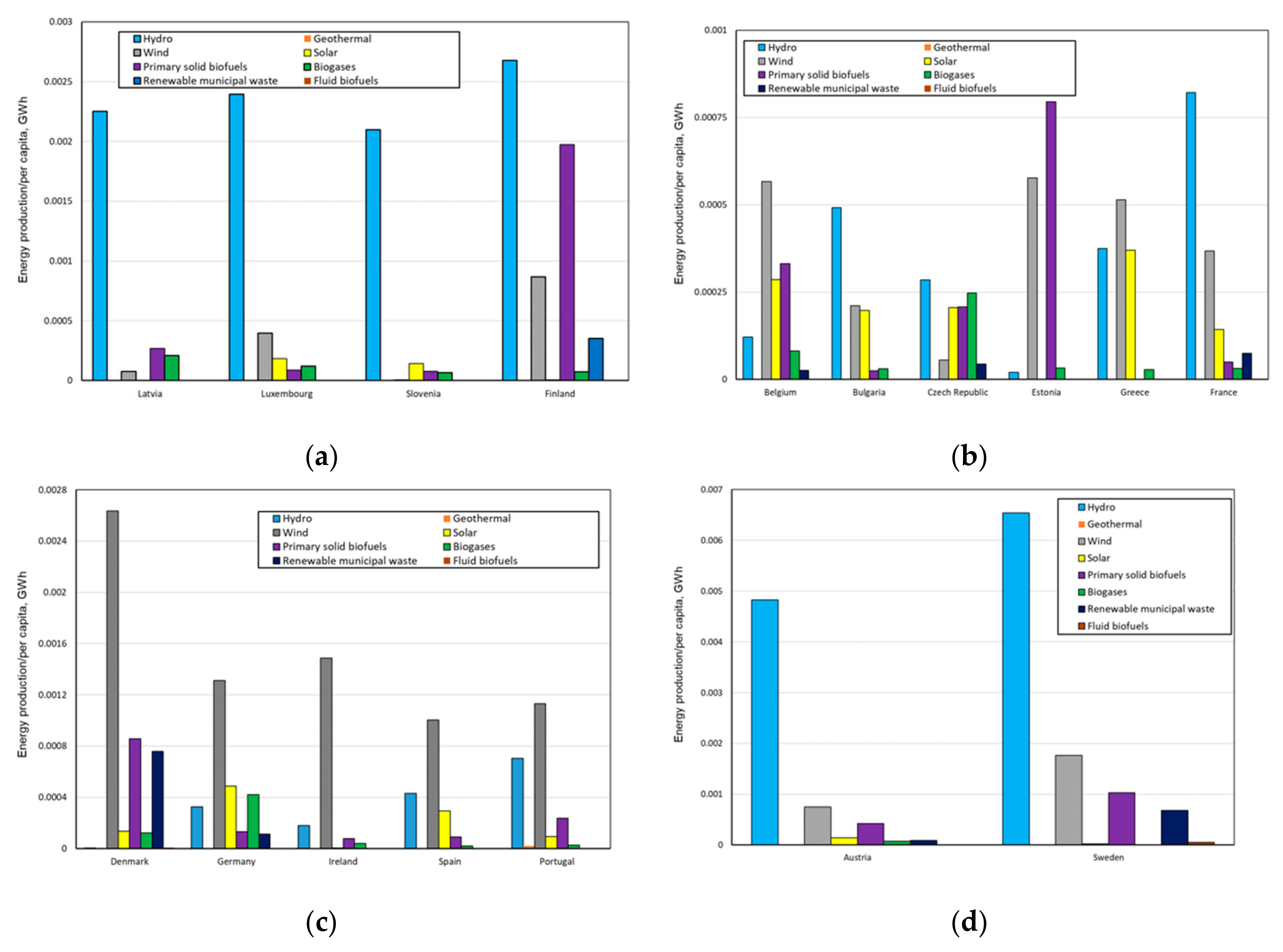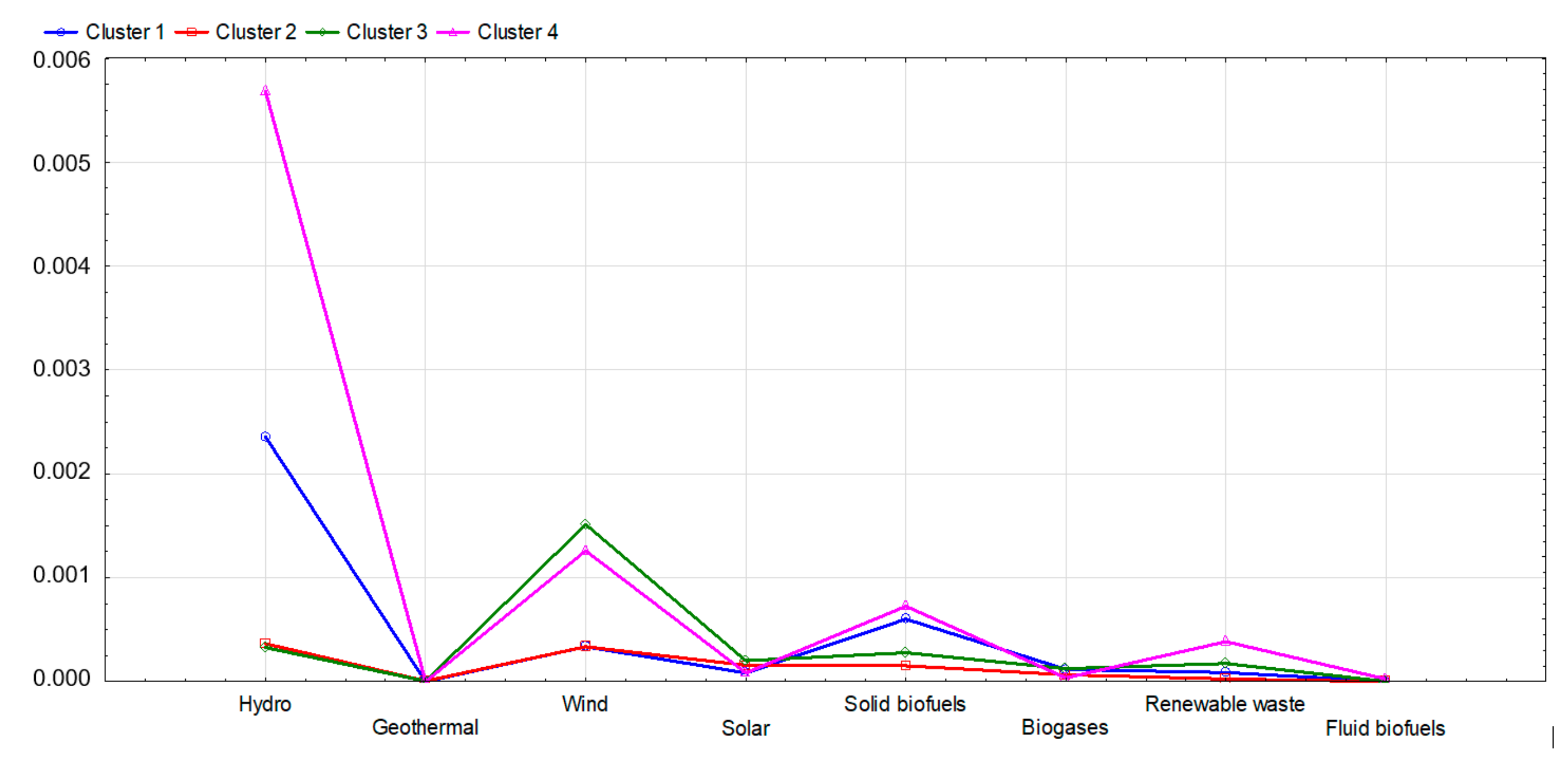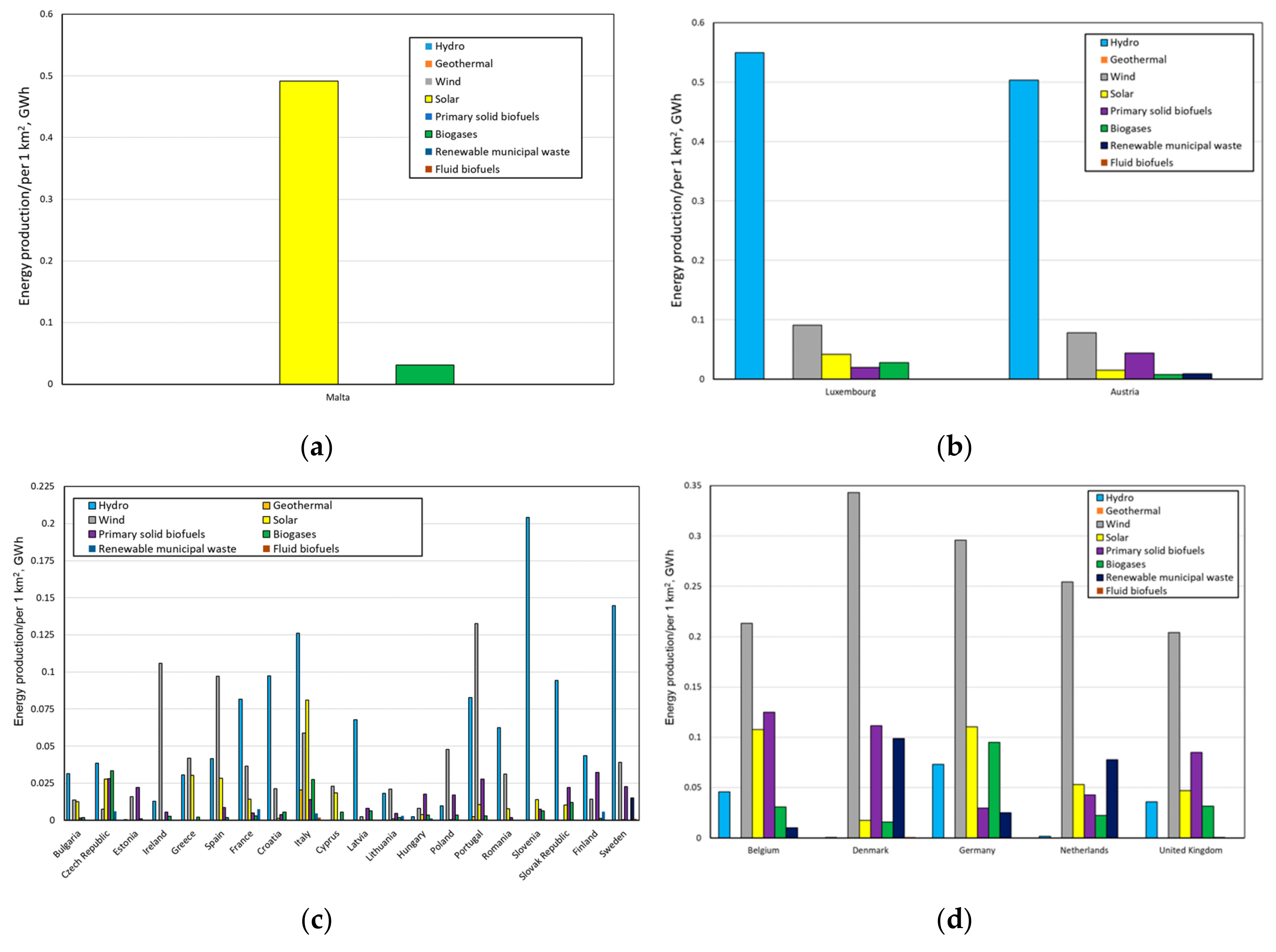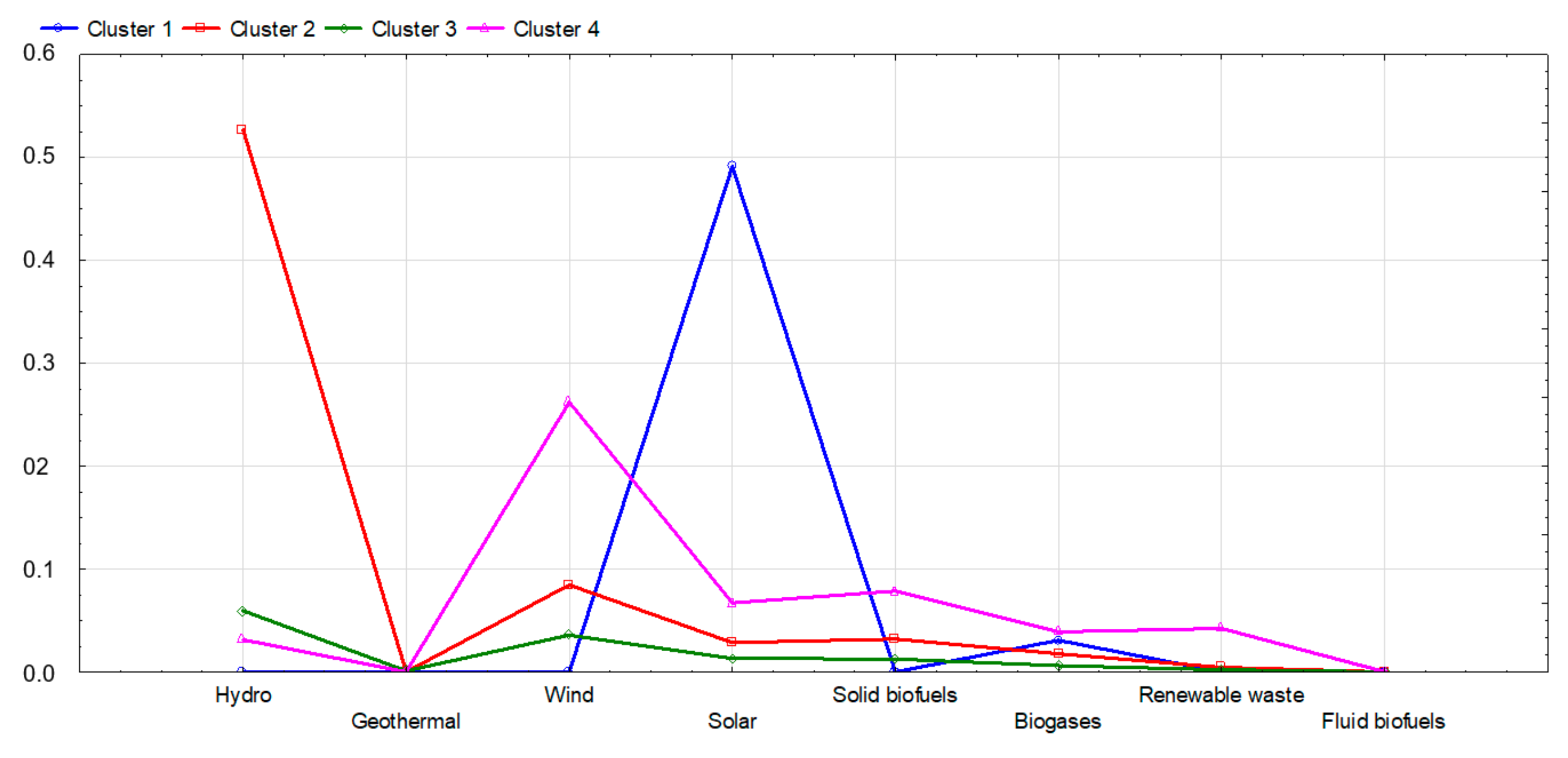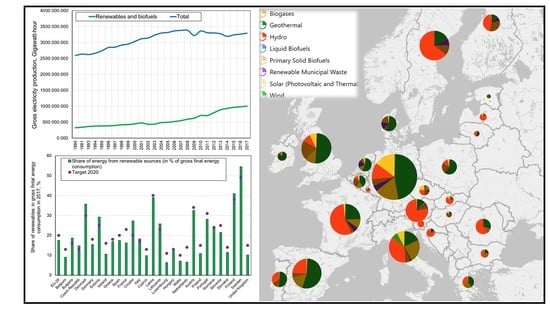1. Introduction
Easy access to cheap energy is one of the most important factors that affect economic development and the well-being of individual societies. Also, it mitigates the effects of poverty [
1,
2,
3]. The dynamic development of the world economy means that the demand for energy is increasing from year to year in virtually all sectors of this economy. Currently, the energy sector is increasingly leaning toward the development and competitiveness of the economies of individual countries [
4,
5,
6,
7].
Unfortunately, the production of electricity and heat in many countries, including the European Union (EU) countries, is largely based on traditional, conventional raw materials [
8]. The source of this energy involves most often fossil fuels, the extraction and combustion of which (in the process of energy production) causes the formation of many harmful substances that enter the natural environment [
9]. The greenhouse gases and other gaseous and dust pollutants generated in this process disturb the balance of the natural environment and pose a greater and greater threat to the entire terrestrial ecosystem [
10,
11]. At present, this threat is already so great that it becomes necessary to take very decisive and global-wide actions to limit the negative impact of the development of our civilization on the environment.
Environmental protection, while ensuring economic development, is becoming one of the main problems of both modern economy and science. From ecological as well as social and economic points of view, this is an extremely important issue. On the one hand, the dynamically developing world economy shows an increasing demand for energy, and on the other hand, the production of this energy causes a huge threat to the natural environment. These problems also apply to the EU countries. In order to reduce emissions of harmful substances, unconventional energy sources are increasingly used for energy production [
12,
13,
14]. Sustainable and closed economy concepts are also being promoted. They aim to reduce the emission of harmful substances and focus on a more complete and rational use of resources, including energy [
15,
16]. The concept of sustainable energy is also gaining importance. Its purpose is to provide energy that meets the needs of the present without compromising the ability of future generations to meet their needs [
17] to finally ensure energy safety based on energy obtained only from renewable energy sources (RES).
The problem of limiting emissions of harmful substances into the natural environment has become one of the main topics discussed by European institutions for years. The EU countries are required to reduce greenhouse gas emissions under the Kyoto Protocol [
18]. The consistent policy of the EU in terms of reducing greenhouse gas emissions, mainly carbon dioxide, forces member states to a variety of activities, which results in the development of the renewable energy sector used for its production, among other initiatives [
19,
20].
According to the strategy presented by the European Commission in 2018, the economy of the EU is to be neutral for both the climate and the environment [
21]. At the same time, however, it is to provide favorable conditions for economic development and for a modern and competitive economy. In order to achieve climate neutrality by 2050, a series of actions and decisions need to be taken in virtually all areas of economic and social life. The solutions proposed by the European Commission presented at the United Nations (UN) COP25 climate summit in Madrid, Spain (December 2019) go even further [
22]. The summit presented a new European climate strategy called “The European Green Deal” [
23]. According to this strategy, by 2050 the economy of the EU should become a “zero-emission” economy, i.e., climate neutral, and by 2030 carbon dioxide (CO
2) emissions should be reduced by 50% (plans include even 55%), in relation to its issue in 1990. These assumptions are more ambitious than those adopted at the UN COP24 Climate Summit, which took place in December 2018 in Katowice, Poland [
24].
The introduction of “The European Green Deal” requires the preparation of a new climate pact, which must be approved and then implemented by all member states. Otherwise, the assumed ambitious goals will not be achieved.
The Just Energy Transition (JET) Fund is to be very important in this respect, as it will constitute the financial base for the Just Transition Mechanism (JTM). This fund is intended for countries and regions that will have problems achieving economic zero emissions and will also support the decarbonization process in Europe [
25].
It is undisputable that the implementation of the Green Deal idea will require the introduction of many political, economic and social measures that will cover all aspects of the lives of the EU citizens. In order to achieve success in this area, it is crucial to conduct an effective and rapid transition process of the energy industry. In particular, this applies to energy production, which, in the EU, is currently largely obtained from conventional sources. This, in turn, is associated with high emissions of this production [
26,
27,
28]. The process of obtaining energy resources also causes high emissions of harmful gases and pollutants [
29,
30]. An alternative that can improve this situation involves renewable energy [
31,
32,
33]. Its development, and thus an increase in the share of energy produced from these sources in the entire energy production, will be the basis for achieving the assumed goals of Europe’s climate neutrality by 2050. Therefore, the development of renewable energy is and will be treated as a priority in activities related to ensuring energy safety in the EU countries and achieving the indicators included in “The European Green Deal” strategy [
34].
The goals of individual EU countries regarding the share of energy from RES in the total consumption of this energy along with the results achieved in 2017 are presented in
Figure 1. The EU strategy assumes an increase up to at least 32% in the share of energy from RES in the total energy consumption in 2030. The original target of at least 27% in 2018 has been adjusted to 32%. By 2020, this level is to be 20% for the entire EU [
35]. In 2017, energy from RES covered 17.5% of the total energy consumption in the EU countries (
Figure 2) [
35,
36,
37].
The presented results show a large diversity of individual EU countries, both in terms of the assumed goal and its achievement.
In general, the adopted assumptions and actions taken to increase energy production (and ultimately also its use) from RES are already bringing very positive effects. Between 1990 and 2017, the share of energy production from RES in relation to the total energy production increased from 12.6% to 30.6%. The total electricity production in the EU countries between 1990–2017, including energy produced from RES, is presented in
Figure 2.
A comparison of energy production from RES in individual EU countries in 1990 and 2017 is shown in
Figure 3.
Figure 4 summarizes the percentage increase in energy production from RES in the EU countries between 1990 and 2017.
The presented data clearly shows that energy production from RES in the analyzed period significantly increased (
Figure 2). However, in the EU countries, these increases were very different (
Figure 3 and
Figure 4). The largest percentage increases in energy from RES were reported in Germany, the Netherlands, Hungary, Belgium and the United Kingdom. In turn, the smallest increases were found in Slovenia, Latvia and Sweden.
The differences depend on the energy policy of individual countries, as well as ecological awareness of societies and their pressure on the authorities in the field of climate protection. The economic aspect is also an important factor. It is undisputable that energy production from RES is much more expensive than from conventional sources. As a result, many countries are not able to cover these costs from their own resources, which undoubtedly limits the possibilities of developing renewable energy. Both the possibilities and availability of individual renewable energy sources are also very significant in this respect.
Figure 5 presents the structure of energy produced from RES in the EU countries in 2017. It includes the eight most important sources from which renewable energy is produced.
When analyzing the presented structure (
Figure 5), it can be stated that, like the consumption of energy from RES (
Figure 1), it is very different in individual EU countries. The reasons for the uneven distribution of energy production from RES in the EU countries are different economic, climatic, hydrological and geological conditions [
36,
38], among other factors.
It is obvious, however, that to achieve the goals of “The European Green Deal” strategy, it is necessary to significantly increase the amount of energy obtained from RES. The production of energy from these sources is practically neutral for the environment, which is undoubtedly its great advantage. Therefore, the EU countries must develop and implement an effective energy policy combined with a climate policy. These policies need to be both coherent and comprehensive and take into account the diversity of the EU countries.
According to the authors, the most important in the process of achieving climate neutrality of individual EU countries are their economic and demographic potentials as well as, to a slightly smaller extent, their geographical location and area. It is also crucial to properly orientate a climate policy so that it is acceptable by individual countries. In this regard, it seems obvious to consider the diversity of these countries. One of the main factors influencing the pace of introduced changes in the field of technological innovation will be the amount of public expenditure allocated for research and development [
39,
40,
41].
For this reason, analyses were carried out to determine similarities between the EU countries in terms of the structure and volume of energy production from RES. These analyses take into account the number of inhabitants of individual countries, their gross domestic product and their area. It was assumed that the pro-ecological policy that is being and will have to be pursued by the EU should be adapted to the specificity of the member states. The key factors that will have an impact on achieving success in implementing ecological ideas will involve convincing societies of the need to introduce changes, the wealth of individual countries and the level of dependence of their economies on energy obtained from conventional raw materials (coal, oil, gas).
Since energy production from RES is to constitute the basis for implementing the idea of “The European Green Deal”, it is reasonable to make a diagnosis of the current state regarding the structure of energy production from these sources in individual EU countries. It is also important to relate this production to the specificity of individual countries and to identify countries with similar structure and volume of this production. This, in turn, should help in the process of implementing this idea and allow for a better distribution and use of funds.
When studying works that look at renewable energy [
32,
39,
40,
41,
42,
43,
44,
45,
46,
47,
48,
49,
50,
51,
52,
53,
54,
55,
56,
57,
58,
59,
60], it can be claimed that so far no studies have been conducted in the scope of the structure of sources from which renewable energy is produced in the EU countries, while taking into account the specificity of individual countries. Undoubtedly, by referring this production to the number of inhabitants, gross domestic product and area of a given country, this specificity is taken into account. The paper presents the results of such analysis covering the eight most important sources from which renewable energy is produced. In the developed methodology, these sources were treated as variables (features), which included energy produced from hydro power, geothermal, wind, and solar sources as well as primary solid biofuels, biogases, renewable municipal waste, and liquid biofuels. The volume of energy production from these sources was compared to the gross domestic product (GDP), the number of inhabitants and area of a given country. Similarities between individual EU countries were determined for all cases. On this basis, these countries were divided into similar clusters (groups), depending on the studied factors (GDP, number of inhabitants and area of a given country).
In order to measure the wealth of individual countries, their GDP value was adopted, in relation to which the amount of energy produced from individual renewable sources was determined. In a similar way, indicators of the amount of produced energy were calculated per one inhabitant of each country (demographic potential) and per one square kilometer of area (geographical potential). The analyses were based on the Eurostat data from 2017 [
37]. The
k-means method was used to determine similarities between individual countries.
The main purpose of the research, was to analyze the structure of sources from which the EU countries produce renewable energy and to determine similarities between these countries in relation to their economic (GDP), demographic (number of inhabitants) and geographical (area) potentials. So far, no analyses have been carried out taking into account these factors, which undoubtedly represents a new approach to this subject.
The paper also presents the results of statistical analyses that were performed for the examined variants. These results were summarized with short comments, while a broader interpretation can be found in the discussion of the results. Undoubtedly, an original and new approach was created with regard to energy market research in the EU by taking into account eight sources of renewable energy production, relating this production to three factors characterizing individual countries (GDP value, population and area) and dividing these countries into similar groups. As far as the proposed changes (“The European Green Deal”) are concerned, such analysis seems to be very valuable and broadens knowledge in the field of both the production and structure of RES. It should also be emphasized that the presented research is one of the first studies relating to the idea of “The European Green Deal”.
The approach presented and the results obtained should therefore indicate and enable a more complete understanding of the problems that may occur in individual EU countries when implementing very ambitious climate strategies.
4. Results
Based on the adopted procedure, the analysis was conducted, the results of which are presented in this chapter. As already mentioned, the analysis covered 28 EU countries for which eight diagnostic variables were adopted, defining the volume of energy production from various RES, which were considered in four different variants.
The purpose of the analysis was to divide the EU countries into similar groups in terms of the structure and volume of energy production from RES in total (absolute values), as well as in relation to the GDP value of a given country, per capita and in relation to the area of a given country (relative values).
The
k-means method used for the analysis requires assuming the
a priori number of clusters to which the EU countries will be assigned. In order to determine an appropriate number of clusters, the preliminary analysis of hierarchical grouping using the Ward’s method was performed (
Figure 9). This method does not require defining the
a priori number of clusters to which countries are to be assigned. Here, the number of clusters is determined based on the algorithm with the Euclidean linkage (the same linkage as in the
k-means method) [
75]. Based on the results of this analysis (
Figure 9), as well as based on the results obtained from Equation (2), it was assumed that the optimal number of clusters adopted for calculations in the
k-means method would be four.
Based on the determined values, the analysis was carried out, which resulted in grouping the EU countries into clusters in such a way that their degree of association with countries belonging to the same cluster was as high as possible, and with countries from other clusters as low as possible. The results are presented in the sections below.
4.1. Results of Grouping the EU Countries According to the Similarity of the Structure of Total Energy Production from Renewable Energy Sources
The first stage of the analysis involved the division of the EU countries into similar groups according to the total amount of energy produced from RES in 2017. Based on the adopted assumption regarding the optimal number of groups, the EU countries were divided into four clusters.
Based on the analyses, diversity measures within and between the clusters were determined, along with degrees of freedom (
df) (
Table 13). The obtained values of
F-statistics, which are the ratio of diversity between clusters to diversity within clusters, allowed the authors to determine the most important grouping variables in terms of their discriminatory power. This means that the larger the
F-statistic for a given variable, the more important it is for assigning given countries to particular clusters.
The analysis of variance showed that wind energy played the largest role in assigning the EU countries to individual clusters. The value of F-statistic for this variable is largest and amounts to 149.33. The second most important allocation criterion was energy generated from biogases (statistical value F = 117.72).
Geothermal energy, for which the value of
F-statistic was only 2.37, was the least important factor for assigning the EU countries based on the adopted criterion. It should be emphasized, however, that each diagnostic variable, i.e., each renewable energy source, ultimately had an impact on grouping the EU countries into homogeneous clusters in terms of both structure and volume of energy production from these sources. It also needs to be emphasized that wind energy in the renewable energy structure in the EU countries is extremely important, because it is the second, after natural gas, largest “source” of electricity in Europe. The share of wind energy in the EU energy mix is around 18% [
79]. At the same time, in the report by [
80], the European Wind Energy Association (EWEA) indicated that by 2030 wind farms could become the largest source of renewable energy in Europe.Since wind energy and biogas energy were significant for assigning the EU countries to specific clusters, countries with similar volumes of energy production from these sources were in one cluster.
The compositions of the created clusters and the distance from their centers (cluster centers) are presented in
Table 14. The greater the distance of a given EU country from the center of the cluster in which this country was located, the greater its diversity from countries whose distance from the center of the cluster was smaller.
The results indicate that the most numerous cluster was created by 21 countries (cluster 3), and also they point to homogeneity of one of the clusters (cluster 2). Germany, as a country with the highest amount of wind and biogas energy production (
Figure 10b), is in Cluster 2, thus creating a homogeneous cluster. No other country is similar to Germany in terms of the amount of energy produced from the selected renewable sources, especially in the production of energy from wind and biogas. The country’s special wind energy program, which guarantees adequate prices, has made the country one of the world’s largest producers of wind energy in recent years. In 2017, as the leader of European wind energy, Germany had a capacity of 56 GW. Other countries include Spain (23 GW), Great Britain (14 GW) (cluster 1) and France (14 GW) (cluster 4) [
79].
A similar situation can be observed with regard to the production of energy from biogas, in which Germany is also the undisputed leader. Both of these energy sources form the basis for energy transition in Germany (Energiewende) and for reducing greenhouse gas emissions and increasing energy efficiency [
68]. This policy has very tangible benefits. The environmentally friendly policy aimed at ensuring that 100% of energy demand in selected sectors is met by renewable sources is often followed by regional and municipal authorities. Similar actions are taken in many EU countries, but Germany is reported to have definitely the biggest number of such initiatives. According to the Global Status Report [
81], around 20 million people in Germany live in regions where energy demand is fully met by RES. In terms of the absolute values, none of the EU countries have achieved such results.
Other countries, i.e., Great Britain and Spain have significantly improved the results in the field of energy production from RES in recent years. Both these countries show great similarities in the production of energy from wind and sun but smaller similarities in the field of energy production from water, primary solids, biofuels, and biogases.
According to the National Infrastructure Commission advisory center, the UK Government should now only invest in renewable energy sources and possibly one nuclear power plant - Hinkley Point C until 2025, as these two sources guarantee both safe and cheap electricity. The Spanish Government, in turn, intends to increase the share of RES in the national electricity production mix to 70% by 2030, and then to 100% by 2050 (which is in line with the idea of “The European Green Deal”). Currently, almost half of the energy consumed in Spain comes from RES [
82]. Spain is the second largest wind energy market in Europe after Germany [
83]. It is worth noting that on the wholesale energy market in Spain, wind energy turns out to be the cheapest of all energy sources present in the country’s energy mix.
Clusters 3 and 4 are the most internally diversified clusters in terms of the structure and volume of energy production from RES. Cluster 3 includes as many as 21 EU countries (including Finland, Belgium, Greece, Denmark, the Netherlands and Poland). This cluster is created by countries with very low energy production from RES (e.g., Malta, Lithuania, Luxembourg), but also by countries where the volume of energy production from RES is much larger (e.g., Denmark, Finland).
In turn, cluster 4 is formed by four countries that are characterized by greater diversity in the structure of energy production from RES. It is worth mentioning that the composition of individual clusters coincides with the composition of the clusters obtained using the preliminary analysis performed by the Ward’s method (
Figure 9). The structure and volume of energy production from RES by countries in individual clusters are presented in
Figure 10.
Basic descriptive statistics characterizing the structure of energy production in the created clusters are presented in
Table 15.
Based on the analysis, it can be concluded that the highest value of renewable energy production was reported for the first homogeneous cluster made by Germany. Germany was found to have produced 224,976.89 gigawatt hours of renewable energy in 2017.
For the other clusters created by very different countries, it is reasonable to use the mean value to determine the amount of renewable energy production by these clusters. A list of mean values of energy production from RES for individual clusters is presented in
Figure 11.
Based on the results, the countries forming cluster 3 were shown to have achieved the lowest mean value of energy produced from RES.
4.2. Results of Grouping the EU Countries according to the Similarity of the Structure of Energy Production from Renewable Energy Sources Per Their GDP Value
The second variant that was analyzed involved the division of the EU countries into similar groups in terms of the structure and volume of energy production from RES in relation to the GDP of a given country. It was adopted that this value is a measure of the wealth of a given country.
It was assumed that the economies of highly developed countries (with high GDP values) should develop the RES sector to the largest extent, and thus also produce the largest amounts of energy from RES. It was therefore reasonable to conduct an analysis that aimed to divide the EU countries into similar groups in terms of the volume and structure of renewable energy production in relation to the GDP of a given country.
This analysis seems particularly interesting in terms of cognition, because according to the report entitled “Renewable Energy Benefits: Measuring the Economics” by the International Renewable Energy Agency (IRENA), an increase in the share of the use of renewable energy up to 36% by 2030 may elevate global GDP by
$ 1.3 trillion or 1.1 percent [
84].
It is therefore also reasonable to check whether there is currently a relationship between the structure and volume of energy production from RES and the wealth of EU countries and what the similarity of these countries is in this respect.
As in the previous variant, the EU countries were divided into four clusters. Their compositions together with the calculated distances from their centers are shown in
Table 16. The measures of diversity within and between the clusters are presented in
Table 17.
The results indicate that this time the basic grouping variable assigning countries to individual clusters was hydropower. For this variable, the value of F-statistic was 85.02. The second grouping variable was wind energy (F = 9.01), which in the first variant was the priority grouping variable. Geothermal energy was reported to have the least impact on the division of countries in this case (as in the previous variant), for which the value of F-statistic was only 0.35. It can therefore be concluded that the created clusters are characterized by a smaller diversity of their number than in the first variant of the analysis.
The first cluster included the countries with the greatest similarity in the structure and volume of renewable energy production in relation to the GDP value of these countries. This group consists of 4 countries with the largest energy production from water, i.e., Croatia, Latvia, Austria and Sweden. Wind energy and primary solid biofuels are also produced in all these countries, but the volume of this production is more diverse. However, these countries do not belong to the countries with the highest value of total energy production from the analyzed renewable sources, nor with the highest GDP value. However, the ratio of energy production from water (the basic grouping variable) to the GDP value of these countries is favorable for them.
Countries in Cluster 2 (Bulgaria, Romania, Slovenia, Slovak Republic and Finland) also show a great similarity in the structure and volume of energy production from RES. In these countries, the ratio of energy production from water to the value of GDP is very favorable, which determined the composition of this cluster.
Countries that are in clusters 3 and 4 are slightly less similar in terms of the structure and volume of energy production from RES.
The analysis also showed that Germany, which is the country with the largest amount of energy production in total from RES, after taking into account the value of GDP, is no longer the clear leader of this cluster. A similar situation can be observed in the case of Spain and Great Britain, which in the first variant of the analysis belonged, next to Germany, to the countries with the largest energy production from RES.
The structure and volume of energy production from RES in relation to the value of GDP by countries in individual clusters is presented in
Figure 12.
The analysis allowed for the determination of total, minimum, maximum and mean values of energy production from RES in relation to the value of GDP in individual clusters (
Table 18).
Figure 13 presents the mean values of energy production from RES in relation to the value of GDP for individual clusters.
When analyzing the results, it can be stated that the countries in cluster 1 are characterized by the highest mean value of energy production from water, biogas and renewable municipal waste in relation to the value of GDP. The lowest mean value of energy production from RES in relation to GDP was reported for countries in cluster 3. This applies to hydro, geothermal and wind energy, solid biofuels and renewable municipal waste
4.3. Results of Grouping the EU Countries according to the Similarity of the Structure of Energy Production from Renewable Energy Sources Per Capita
The third variant of the analysis involved grouping the EU countries into similar clusters in terms of the structure and volume of energy production by the number of inhabitants of these countries. It seemed reasonable to check whether there is a relationship between the structure and volume of energy production from RES and the number of inhabitants, and what the similarity of these countries is in this respect.
As in the previous variants, the EU countries were divided into four groups. Measures of diversity within and between the created clusters are presented in
Table 19.
In this variant, the highest value of F-statistic, which defines the most important grouping variable in assigning countries to clusters, was achieved by hydropower (F = 113.91), while the second significant grouping variable was wind energy (F = 14.65). The grouping variables in this case were the same as for the analysis regarding the structure and volume of energy production from RES, taking into account the GDP value of a given country.
The variable that was found to have the least impact on the results, as in the previous two variants of the analysis, was geothermal energy, for which the value of F-statistic was 0.13.
The created clusters and their compositions, as well as the distances from the centers of these clusters are presented in
Table 20. The structure and volume of energy production from RES per capita by countries in individual clusters are presented in
Figure 14.
The results showed that the division of countries according to the structure and volume of energy production from RES per capita essentially differed from the division by the structure and volume of energy production from these sources in total (
Table 14), as well as from the results obtained in the variant including the value of GDP (
Table 16).
The most energy from RES per capita was found to be generated by countries from cluster 4 (Sweden and Austria), and the least-by countries from cluster 2 (e.g., Poland, France, Malta, Belgium). Among the countries producing the lowest energy per capita, Malta was shown to produce the least energy in total.
On this basis, it can be concluded that both the greatest similarities and differences between the countries were found in cluster 2 (17 countries, including France, Great Britain, Poland, Italy, the Czech Republic). At the same time, countries that are in clusters 2 and 3 were shown to share similarities (determined on the basis of a small distance from the center of the cluster for individual countries).
It was also noted that clusters 1 and 3 included countries that “stood out” from other countries from these clusters. In the case of cluster 1, it was Finland, and in the case of cluster 3, it was Denmark (for them, the distances from the centers of their clusters are 0.000541 and 0.0005059, respectively).
Figure 15 shows the mean values for each cluster.
Table 21 presents the total, minimum, maximum and mean values of energy production from RES in individual clusters per capita of a given country.
When analyzing the results, it can be stated that the demographic factor significantly affected the composition of clusters and their number.
4.4. Results of Grouping the EU Countries according to the Similarity of the Structure of Energy Production from Renewable Energy Sources Per Area
The last variant of the analysis involved grouping of the EU countries by relating the amount of energy produced from RES to their area.
As in the case of the previous variants, the EU countries were grouped into four clusters, the compositions of which are presented in
Table 22. In turn,
Table 23 presents the measures of similarity and diversity along with the analysis of variance.
The analysis of the value of F-statistic showed that the most important grouping variable for this variant was solar energy (F = 129.4). Hydrogen energy (F = 42.76) was the second significant grouping variable, which was the most important in the two previous variants. Thus, in this variant, its significance in grouping countries into homogeneous structures was observed to have slightly decreased. It is worth noting that the priority (main) grouping variable in this analysis variant is completely different when compared to the previous variants.
However, the least significant variable from the point of view of assigning countries to clusters did not change, as for the fourth time, it was geothermal energy (F = 0.14).
The analysis of the results indicates that the division of countries into homogeneous clusters according to the structure and volume of energy production from RES per 1 km2 essentially differed from the previously obtained divisions.
In cluster 1, Malta was reported to be the country with the smallest area among all analyzed countries (and also the smallest number of inhabitants). Among all the EU countries, it is a country where the largest amount of renewable energy is produced from solar energy (i.e., a priority grouping variable) (
Figure 16a). Malta is also a country where the production of energy from RES is lowest.
Cluster 2 was made up by Luxembourg and Austria. Although these countries differ significantly in their area, the structure and volume of energy produced from RES per area of these countries was found to be very similar.
The analysis found that as many as 20 EU countries showed similarities in terms of the structure and volume of energy production from RES per area. These countries form cluster 3. At the same time, due to its abundance, this cluster was found to have the greatest internal diversity.
The structure and volume of energy production from RES in relation to the area for countries located in individual clusters is presented in
Figure 16.
Table 24 shows the total, minimum, maximum and mean values of energy production from RES in individual clusters per 1 km
2 of area, and
Figure 17 shows the mean values of this production for each cluster.
5. Discussion
When studying the presented data and results, it can be concluded that in recent years, there has been a large increase in energy production from RES in the EU countries (
Figure 2,
Figure 3 and
Figure 4). Along with the increase in production, the consumption of this energy is also on the increase [
84]. At the same time, a large variation in the overall production of this energy and the structure of this production in individual countries can be noted.
Based on the overall production of energy from RES in the EU countries, Germany was found to be the largest producer (about 22% of the studied energy sources), followed by France, Italy, Sweden and the United Kingdom, the production of which accounts for around 10% of the EU production (
Table 1).
However, when taking into account the structure and volume of renewable energy production from the studied sources, it is clear that the similarities in both the structure and the volume of renewable energy production among the EU countries with the highest production is shown by Spain and the United Kingdom (cluster 1), France, Italy, Sweden and Austria (cluster 4) (
Table 14). Germany, in turn, was found to be a homogeneous cluster, not showing enough similarities to be compared with other EU countries (
Table 14). Much smaller amounts of energy from RES were shown to be produced in other countries, including Poland and Spain, i.e., countries with a large area and large population. The analysis of these results also clearly indicates the countries in which energy is based on conventional raw materials. This applies primarily to Poland, Slovenia, Croatia, Hungary and several smaller countries.
The share of energy produced from RES in gross final energy consumption is one of the main indicators of the strategy “Europe 2020” [
85,
86]. The goal of this strategy (adopted before “The European Green Deal” strategy) is to achieve about 20% share of energy from RES in the final energy balance in 2020, and at least 32% by the end of 2030.
In this respect, Sweden, Finland, Latvia, Denmark and Austria use the most renewable energy (
Figure 1). Sweden is the leader in this respect, while eleven member states were found to have already achieved the 2020 goals. Apart from Sweden, they include Bulgaria, the Czech Republic, Denmark, Estonia, Croatia, Italy, Lithuania, Hungary, Romania, and Finland (
Figure 1). However, Latvia and Austria are very close to achieving the assumed share of renewable energy in total energy consumption, which is only about 1 percentage point from their 2020 targets (
Figure 1).
In this respect, the countries with the highest absolute amount of energy produced from RES present quite poorly. Although Germany, Great Britain, France and Spain are leaders in the absolute amount of energy produced from RES, these achievements are low when compared to the final energy balance (
Figure 1). The general energy demand of these countries is so large that the amount of energy produced from RES meets their needs only to a small extent. This, in turn, means that their energy deficit is satisfied from other energy sources, including mostly conventional sources that are very harmful to the environment.
Therefore, further analyses included determining the amount and structure of energy produced from RES in relation to the value of GDP (
Table 2), the number of inhabitants (
Table 3) and the area (
Table 4) of individual countries.
It was assumed that by contrasting them only with the absolute values of energy produced from RES would not fully reflect the real state of renewable energy in Europe. Undoubtedly, this approach gives a fuller and more objective picture of the state of this energy sector. This is confirmed by the results obtained from the analyses for three additional variants, which differ significantly from the grouping results for the total amount of energy produced from RES.
When converting the amount of energy produced from RES to the GDP of a given country (measure of wealth), great similarities between such countries as Germany, Poland, Estonia, Greece, Lithuania, Portugal and Denmark were reported. This means that in relation to the value of GDP, the amount of energy produced from RES is very similar in these countries, despite the fact that in terms of the absolute values, these quantities significantly differ.
Sweden, Latvia, Croatia and Austria were found to be most favorable for this variant (cluster 1,
Table 16), for which the relationship between the amount of energy produced from RES and their GDP is highest. Also, the division into similar groups for this variant is more even than in the case of the analysis of the absolute energy production values. This creates favorable conditions for exchange of experience and cooperation between countries in a given cluster and joint application for funds intended for energy transition.
Another factor that was taken into account in the presented analysis is the demographic factor. It was assumed that the ratio of the amount of energy produced from RES to the number of inhabitants of a given country determines the state of public awareness in the field of climate protection. This is a very general assumption, but according to the authors, the value of this indicator may undoubtedly point to social commitment to environmental protection.
The analysis shows (
Table 20 and
Figure 14) that the largest amounts of energy produced from RES per capita were reported for countries in cluster 4 (Sweden and Austria) and cluster 1 (Finland, Denmark, Luxembourg and Latvia). On the other hand, the smallest amounts were observed for countries from cluster 2 (Hungary, Cyprus, Malta, Poland, Bulgaria, as well as the Czech Republic and the United Kingdom, among other countries). Also, in this case, the division of countries into similar groups was found to be different than in the case of the division by the total amount of energy produced from RES (
Table 14).
Therefore, it is reasonable to state that the reference of energy production from RES to the value of GDP and the number of inhabitants of a given country gives results that definitely reflect the specificity of individual countries rather than just an analysis of the absolute values of this production. They also define the degree of utilization of the economic and demographic potentials of a given country. Countries that achieve the best results for these criteria are undoubtedly among the leaders in introducing energy transition. It can also be assumed that the societies of these countries are more aware of the need to introduce changes related to climate protection.
In the next analysis, the amount of energy produced from RES was compared to the area of a given country. It was assumed that the size of a given country should have an impact on the structure and amount of energy produced from RES. It is obvious that the geographical location of the country and its area affect the availability of RES. It seems that this indicator, of course, to some extent determines the degree of the use of “geographical potential” in the production of energy from RES.
It seems reasonable to state that countries with a large area have easier access to renewable energy sources, especially in the field of wind and solar energy. Undoubtedly, this is a certain simplification, but according to the authors, the reference of energy production from RES to the area of a given country can, as already mentioned, be treated as a degree of utilization of the country’s “geographical potential”.
The results (
Table 22 and
Figure 16) indicate that also in this respect the division of the EU countries into similar groups is different versus the division that takes into account the absolute amounts of energy produced from RES. Austria and Luxembourg obtained the best results for this variant. The structure of renewable energy production in these countries is also very similar. The lowest rates were obtained by countries from cluster 3 (e.g., Poland, Bulgaria, Lithuania, Cyprus, Estonia and Hungary). It can be claimed that despite the favorable geographical conditions, these countries are not achieving satisfactory results.
To sum up, it should be noted that the results show that the problem of reducing harmful emissions in the energy industry in the EU countries is very complex. It requires an in-depth analysis that will cover many factors. Undoubtedly, the results presented in this paper and their discussion constitute a new approach to the analysis of this problem. Renewable energy sources must replace conventional sources as soon as possible.
This applies mainly to the heating and cooling sectors as well as the transport sector, as these sectors make the most use of conventional energy sources (coal, oil and gas). The integration of these sectors, in particular the heating and cooling sectors with the electricity sector must be carried out in two ways: through both electrification and technological innovation [
87,
88,
89]. The introduction of these solutions requires the development of a comprehensive energy policy based on both knowledge and innovative solutions.
In order to achieve the assumed climate goals, a fair and reasonable orientation of finances toward energy transition in many EU countries is required. The presented analyses should support this process and direct it to the analysis of the needs and possibilities of designated similar groups of countries. This creates a possibility of more efficient use of funds than if all countries were treated according to one criterion.
The diversity of the EU countries, clearly demonstrated in the study, shows that such a course of the EU actions should give the best results.
The results of grouping the EU countries into homogeneous clusters (groups) in terms of the structure and volume of energy production from RES presented in the article indicate that the analysis in terms of the absolute amount of energy produced from RES does not fully describe the actual state of this phenomenon. Thus, it was justified to extend this analysis to new factors that allowed a more accurate assessment of the similarity of the EU countries in the field of renewable energy production.
In order to develop technologies related to renewable energy sources, the knowledge of the countries which have achievements and experience in a given area should be used. However, it should be remembered that what kind of renewable energy sources are worth developing depends also on the natural conditions of the country. Solutions that work well in countries with high sunshine will not work so well in countries with low sunshine. The same applies to investing in water and wind energy.
The economic and demographic potentials of a given country are also crucial to be considered. As already mentioned, obtaining energy from RES is very expensive and requires considerable investments. Public consent to these investments is also a key factor in this respect.
The results also indicate a large variety of sources from which renewable energy is obtained in the EU countries. This is due to the geographical location of these countries, their financial capabilities, traditions as well as economic potential and social awareness. Especially in this area, there are great opportunities for cooperation and exchange of experience between individual countries, which should result in a more complete and effective use of individual renewable energy sources.
6. Conclusions and Policy Implications
In the context of the negative events observed for several due to climate change, further global economic growth, which is based on the use of fossil fuels and thus the increasing pollution of the natural environment, is unreal and impossible to maintain. Forecasts regarding the state of the natural environment for the coming years point to the need to introduce very strong and rapid changes to improve this situation. The concept of “The European Green Deal” meets these challenges and is undoubtedly a very ambitious plan to provide Europe, as the first continent, with the so-called climate neutrality in 2050. However, this goal requires huge financial outlays, organizational and economic changes in most EU countries, including social acceptance of the introduced changes in individual countries.
It is undisputable that this concept is a great opportunity for economic development of the EU and allows for the achievement of climate advantage over the rest of the continents. However, to reach the “zero emission” of the European economy in 2050, enormous investments and legislative changes will be necessary. In particular, this applies to countries where the energy sector is based on conventional raw materials. It will not be easy to conduct energy transition in these countries, as it will require large financial resources and social acceptance. An undoubted chance for the effective implementation of this idea and achievement of the assumed goal is the Just Transition Fund, which is to finance the costs of necessary changes.
It should also be noted that the EU is responsible only for around 10% of global emissions of GHG and harmful substances [
90,
91]. It can therefore be assumed that the success of the Green Deal concept will be proof that zero-emission economy is possible. This, in turn, should encourage other countries and continents to introduce similar solutions. With the current state of public awareness and the widespread phenomena of negative climate change, the improvement of the state of the environment, and hence the climate should become an absolute priority for the entire modern world.
In order to effectively direct the necessary changes related to improving the quality of the natural environment in Europe, it is reasonable to conduct research to broaden the knowledge of the current state of European energy, with special emphasis on renewable energy. It is certain that energy produced from RES is definitely more ecological and constitutes a real alternative to production from conventional sources. The current state of the art and developed technologies also enable its wider and more effective application. Nevertheless, this process is very expensive and requires a consistent, thoughtful and comprehensive policy.
Both the research and results presented in this paper are to support this process and broaden the knowledge of the structure of renewable energy production in the EU countries. The new approach to energy production analysis presented in this paper, which takes into account the economic, demographic and geographical potentials of individual countries, has enabled the acquisition of new knowledge in this area. It was also important to show the diversity of these countries.
It seems insufficient to rely only on the analysis of the absolute volumes of energy production from RES, especially in view of the need to develop a new climate policy for economically diverse EU countries. The multi-criteria division of the EU countries into similar groups presented in the paper creates an opportunity to develop effective solutions dedicated to individual groups. It should also encourage close cooperation between the countries in these groups. Exchange of experience and joint resolution of similar problems should improve the effectiveness of introduced changes and ensure energy safety of these countries
In addition, a common social policy is also very important in this respect. In countries with similar problems, it will be much easier to implement even not very popular actions, for example, those associated with closing mines and limiting energy production from coal. For similar groups of countries presented in this article, financial resources should also be dedicated and distributed (e.g., from the Just Transition Fund).
The question remains whether countries with the highest absolute amount of energy produced from RES fully use their economic and demographic potentials and whether this production is related to the size of these countries. The conducted research and the obtained results indicate that the potentials of these countries (the richest in Europe) are not fully used to improve the quality of the climate. However, in order to achieve the goals of “The European Green Deal”, all EU countries must jointly implement its assumptions.
The use of taxonomic methods to analyze the structure and volume of energy production from RES in individual countries in relation to the new criteria that take into account the specificity of these countries fulfilled its task. The results undoubtedly support the assessment of the current state of renewable energy in the EU and are a source of new knowledge that can be used to improve the state of the environment.
It should also be emphasized that the presented work is one of the first paper relating to the idea of “The European Green Deal” presented in December 2019. The authors hope that it will start a broad discussion on this idea and will make an important contribution to the development and implementation of an effective EU climate policy.
